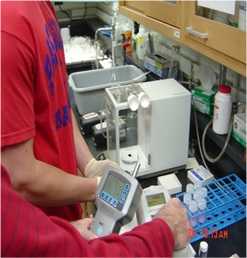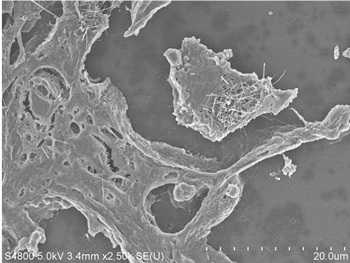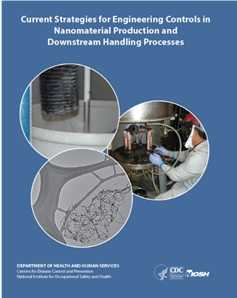Nanotechnology Research Center
Burden, Need and Impact
The NTRC identifies priorities to guide research investments, and bases those priorities on the evidence of burden, need and impact.
Burden
Nanotechnology is the understanding and control of matter at dimensions between approximately 1 and 100 nanometers, where unique phenomena enable novel applications. The President’s 2017 Budget requests $1.4 billion for the National Nanotechnology Initiative, with a cumulative total of nearly $24 billion in nanotechnology research since 2001. However, less than 3% of the cumulative Federal budget has been directed to study of the Environmental, Health and Safety (EHS) potential of nanomaterials. The US recognized that the historical investment was not sufficient to address EHS knowledge gaps, and the amount projected for FY 2016 EHS research is approximately 10% the total NNI investment.
Air pollution (consisting of incidental nanoparticles) epidemiology has demonstrated that ultrafine particles can affect the lung, cardiovascular, and other organ systems; and are responsible for excess respiratory and cardiovascular mortality. Recent air pollution and animal studies have shown various ultrafine and nanoscale particles are linked to adverse neurological changes. Welding fumes, which contain several types of nanoparticles, are known to cause toxicological and carcinogenic effects. Development and commercialization of nanotechnology-based products and applications is occurring at a rapid rate, making it imperative that more information on the potential health hazards from exposure to engineered nanomaterials (ENMs) be generated. The number of workers exposed to EMNs is not known, but market reports indicate that large and growing quantities of ENMs are being used in commerce, and workers are involved throughout their manufacture, formulation and use to create nanomaterial products. While It is too early to identify the exact burden of ENMs to workers, it is reasonable to assume that health effects from exposure to engineered nanoparticles could be similar to ultrafine air pollution or other dusts and fumes that cause pulmonary and cardiovascular effects. Some engineered nanoparticles appear to be 10-100 times more reactive or potent than their bulk counterparts, so one would expect a commensurate increase in burden for a given exposure. Based on these developing trends, burden in terms of morbidity and mortality has the potential to be large, significant and costly. Failure to develop the technology responsibly, including worker protection, may ultimately place a burden on capital, entrepreneurial investment, and ultimate benefit to society.
Below are the priority areas for the NTRC based on the Need and Impact.
1. Conduct research to contribute to the understanding of the toxicology and internal dose of emerging ENMs.

Need. There is need for an expeditious approach to understand the potential toxicologic properties of the large number of nanomaterials in research and commerce now and in the future. NIOSH has specific experience with nanotoxicology, including identifying adverse health effects in animals exposed to various nanomaterials, determining how nanomaterials interact with the biological systems, and identifying relationships between specific physicochemical properties of nanomaterials and adverse biological effects. NIOSH is the only government agency to develop occupational exposure limits for two types of engineered nanomaterials (carbon nanotubes and nanofibers, and ultrafine titanium dioxide).
Impact. This research will contribute to the body of knowledge about the adverse health effects in animals exposed to various nanomaterials. This research will have a direct impact on the risk assessment of potential outcomes of exposed workers; contribute to epidemiologic research; and provide background that can be used to create guidance on control technologies and medical surveillance.
2. Determine whether nanomaterial toxicity can be categorized on the basis of physicochemical properties and mode of action.

Need. A vast number of potential new nanomaterials are possible and could result in a seemingly limitless combination of physicochemical factors (e.g., size, shape, surface area, solubility, chemical properties, and trace components) of nanoparticles that may influence their toxicity. Given that it is not possible to evaluate all combinations of physicochemical properties for all nanomaterials, we need to determine the biological mechanisms for toxic effects (e.g., oxidant stress, dissolution, fibrogenicity, and hydrophobicity) and how key chemical and physical factors may influence these mechanisms.
Impact. This research would provide a basis for developing predictive algorithms for structure/function relationships and comparative toxicity analyses for risk assessment. Categorical exposure limits (or hazard banding) in addition to specific exposure limits for nanomaterials will provide the occupational health community with a target value and with sampling information to protect workers over a working lifetime.
3. Foster the collection, management, and dissemination of relevant information to protect nanomaterial workers.

Need. Nanotechnology and the commercialization of products and devices containing engineered nanomaterials could help address critical global problems concerning energy, transportation, pollution, health, and food. The potential benefits of nanotechnology are huge, and these benefits should be realized. Nonetheless, there is concern that the full potential of societal benefits may not be realized if cautions about the adverse human health effects are not heeded and concerns are not honored. Timely, targeted research is needed to continue to define hazards, exposures, and risks and to provide guidance for safe handling of nanomaterials. The NIOSH NTRC has collected, managed, created, and shared nanomaterial risk management guidance to protect nanomaterial workers.
Impact. Various target audiences such as nanotechnology workers and employers, occupational safety and health professionals, policy-makers, decision-makers, and/or the scientific community in research, manufacturing, construction, mining, oil and gas, and healthcare can apply NIOSH guidance to responsibly develop, handle, and commercialize nanomaterials. Through strategic planning, research, partnering with stakeholders, and making information widely available, the NTRC will continue supporting the responsible development of nanotechnology by translating research into effective risk management guidance and practices that ultimately result in reducing potential injuries and illnesses associated with occupational exposure to engineered nanomaterials.
Reference
- NSF [2011]. Nanotechnology research directions for societal needs in 2020: retrospective and outlook summary. National Science Foundation. In: Roco M, Mirkin C, Hersan M, eds. Science Policy Reports. New York: Springer (DOI: 10.1007/978-94-007-1168-6_5).
- Page last reviewed: October 21, 2016
- Page last updated: August 17, 2017
- Content source:
- National Institute for Occupational Safety and Health Office of the Director


 ShareCompartir
ShareCompartir